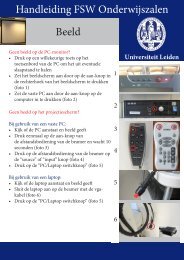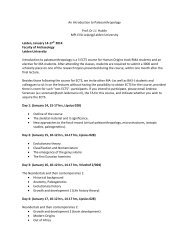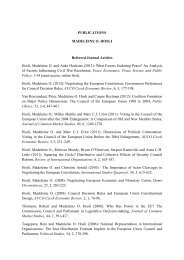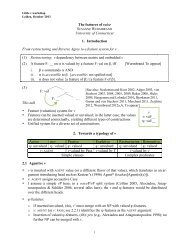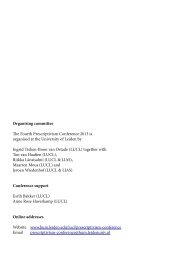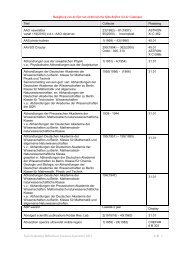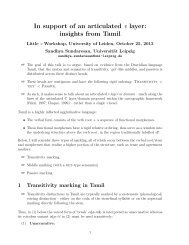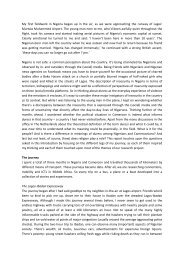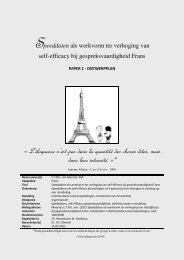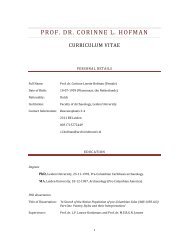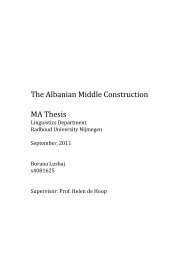Little v as domain/phase delimiter
Little v as domain/phase delimiter
Little v as domain/phase delimiter
You also want an ePaper? Increase the reach of your titles
YUMPU automatically turns print PDFs into web optimized ePapers that Google loves.
<strong>Little</strong> v <strong>as</strong> <strong>domain</strong>/ph<strong>as</strong>e <strong>delimiter</strong><br />
Lisa deMena Travis, McGill University<br />
Among the many functions of little v, one is to delimit a <strong>domain</strong> (thematic <strong>domain</strong>:<br />
Grohman (2003); l-syntactic <strong>domain</strong>: Hale and Keyser (1993)) or a ph<strong>as</strong>e (e.g. Chomsky<br />
(2001)). I will investigate this use of little v, using syntactic, semantic, and, in particular,<br />
phonological evidence, to examine possible fine-tuning of the edge of the vP. There are three<br />
questions in particular that I will examine.<br />
• Does v send VP to Spell-out?<br />
• Are there heads between T and v that could be ph<strong>as</strong>e heads?<br />
• Can the <strong>domain</strong> of vP be extended?<br />
First, using phonological arguments, I will show that v does not send its complement to<br />
Spell-out but rather v along with VP must be spelled out in the same ph<strong>as</strong>e. The relevant<br />
data come from Malayalam lexical causatives <strong>as</strong> discussed in Marantz (2007) and Michaels<br />
(2009) where lexical causative morphemes, arguably in v, can be seen to be within the<br />
first ph<strong>as</strong>e in terms of the type of phonology that they exhibit. We see the relevant data<br />
below where the lexical causative triggers fusion because the causative suffix, -kk, is attached<br />
within a ph<strong>as</strong>e (1b) and the productive causative triggers vowel insertion because the same<br />
morpheme is attached outside the ph<strong>as</strong>e (1c).<br />
(1) a. booṭṭ@ muNN-i<br />
boat sink-p<strong>as</strong>t<br />
‘The boat sank.’<br />
b. kuṭṭi booṭṭ@ mu-kk-i.<br />
child boat sink-cause-p<strong>as</strong>t<br />
‘The child sank the boat.’<br />
c. kuṭṭi booṭṭ@ muNN-icc-u.<br />
child boat sink-cause-p<strong>as</strong>t ‘The child caused the boat to sink.’<br />
Using semantic arguments, I claim that head movement cannot explain this tauto-ph<strong>as</strong>al<br />
behaviour. I follow Marantz (2007) and Travis (2000) in <strong>as</strong>suming that both semantic<br />
and phonological idiosyncratic behaviour can occur within the first ph<strong>as</strong>e. Then I provide<br />
arguments from VP ellipsis (see Goldberg 2005) that heads are interpreted in their merged<br />
positions. If this is the c<strong>as</strong>e, semantic idiosyncr<strong>as</strong>ies occurring between v and V point to<br />
their being merged within the same Spell-out <strong>domain</strong>.<br />
Second, using phonological arguments from lexical versus productive causatives in Malag<strong>as</strong>y,<br />
I propose that another functional head above v (E <strong>as</strong> in Travis (2000)) is also spelled<br />
out within this first ph<strong>as</strong>e. In Malag<strong>as</strong>y there is an extra morpheme, f-, that appears between<br />
the lexical causative prefix and the productive causative prefix. Using a root that begins<br />
with f to create a minimal contr<strong>as</strong>t, we can see that when the causative morpheme attaches<br />
within a ph<strong>as</strong>e, fusion occurs (n+f →m) but when the causative morpheme attaches across<br />
a ph<strong>as</strong>e boundary, pren<strong>as</strong>alization occurs (n+f → m p).<br />
1
(2) Productive causative (PC)<br />
PC of lexical causative m+an+f+an+fatra mampamatra<br />
‘z makes y me<strong>as</strong>ure x’ n+f→ m p; n+f→m<br />
Third, I argue that the <strong>domain</strong> of the first ph<strong>as</strong>e (EP) cannot be extended in the manner<br />
suggested by Embick (2010) to account for root allomorphy in, for example, English. This<br />
is clear in Ojibwe where tense morphemes are attached outside of the first ph<strong>as</strong>e. In Ojibwe,<br />
vowel hiatus is resolved through V deletion within a ph<strong>as</strong>e and across ph<strong>as</strong>e boundaries<br />
allowed to remain (see Piggott and Newell (2005) for details). We can see in the example<br />
below that vowel hiatus remains unresolved following the tense prefix, indicating that Tense<br />
must be outside of the first ph<strong>as</strong>e.<br />
(3) a. wi:a:gamose:<br />
‘he will walk in snowshoes’<br />
wi:-a:gam-ose:<br />
‘future-snowshoe-walk’<br />
b. gi:a:gamose:<br />
‘he walked in snowshoes’<br />
gi:-a:gam-ose:<br />
‘p<strong>as</strong>t-snowshoe-walk’<br />
If <strong>domain</strong>s cannot be extended, a question is raised about the <strong>domain</strong> of root allomorphy. I<br />
will explore this question further without necessarily arriving at a solution.<br />
The take-home message is that phonological and semantic data can be used to investigate<br />
what at first might appear to be a purely syntactic issue arriving at a more fine-tuned<br />
understanding of the role of v.<br />
References<br />
Chomsky, N. (2001). Derivation by ph<strong>as</strong>e. In Kenstowicz, M., editor, Ken Hale: A Life in<br />
Linguistics, pages 1–52. MIT Press, Cambridge, M<strong>as</strong>sachusetts.<br />
Embick, D. (2010). Localism versus Globalism in Morphology and Phonology. MIT Press,<br />
Cambridge, M<strong>as</strong>sachusetts.<br />
Goldberg, L. M. (2005). Verb-Stranding VP Ellipsis: A Cross-Linguistic Study. PhD thesis,<br />
McGill University, Montreal.<br />
Grohmann, K. K. (2003). Prolific Domains: On the Anti-Locality of Movement<br />
Dependencies. John Benjamins, Amsterdam, The Netherlands.<br />
Hale, K. and Keyser, S. J. (1993). On argument structure and the lexical expression of<br />
syntactic relations. In Hale, K. and Keyser, S. J., editors, The view from building 20,<br />
pages 53–110. MIT Press, Cambridge, M<strong>as</strong>sachusetts.<br />
Marantz, A. (2007). Ph<strong>as</strong>es and words. In Choe, S.-H., editor, Ph<strong>as</strong>es in the Theory of<br />
Grammar, pages 191–222. Dong In, Seoul.<br />
Michaels, J. (2009). To alternate or not to alternate: What is the boundary? In North E<strong>as</strong>t<br />
Linguistic Society 40 (NELS 40).<br />
Piggott, G. and Newell, H. (2005). Syllabification and the spell-out of ph<strong>as</strong>es in Ojibwa<br />
words. In McGill Working Papers in Linguistics 20. McGill Department of Linguistics.<br />
Travis, L. d. (2000). The L-syntax/S-syntax boundary: Evidence from Austronesian. In<br />
Paul, I., Phillips, V., and Travis, L., editors, Formal Issues in Austronesian Linguistics,<br />
pages 167–194. Kluwer Academic Publishers, Dordrecht, The Netherlands.<br />
2



